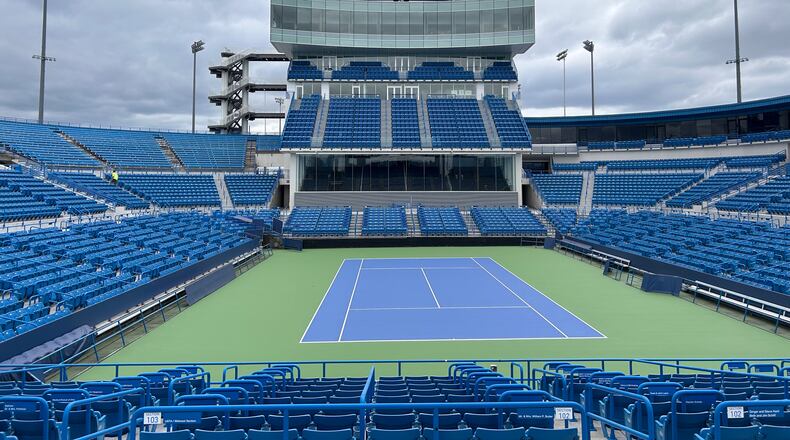Martin explained to reporters on Thursday that tournament owner Beemok Capital will make its decision soon after the upcoming tournament. Whether it moves forward with $150 million renovations in Mason or a new $400 million facility in Charlotte, construction would need to begin this fall to meet the 2025 deadline.
Independent of the tournament’s future, Martin said his focus has been on improving the product folks will experience from Aug. 8 to Aug. 20 of this year.
“We’re working urgently, right now, to make sure that we’re ready to entertain everybody this year the best way they’ve been entertained here in Cincinnati, but in the long term, there’s big, big improvements coming,” Martin said.
Improvements are centered on amenities for both fans and players — an aspect that Martin feels the Western and Southern Open needs to catch up on. For fans, there will be renovated suites, an extended fan zone, new vendors and a higher volume of video boards to observe all the action. For players, there will be a revamped lounge, recovery rooms and fitness spaces along with a better dining experience.
Martin described the improvements as a precursor of what’s to come if the tournament should stay local.
“Our 2025 plans for expanding the property is what’s going to catch us up and hopefully pass a lot of our peer group,” Martin said. “The improvements this year and next year are to make sure that everybody knows we’re going dramatically in the right direction so that when we get to the big renovation, people are gonna be thrilled.”
Martin, a proud midwesterner, touched on the unique position the Western and Southern Open has always had on the professional tennis circuit.
The tournament is one of the 15 most prestigious tournaments in the world, with congruent tournaments hosted in cities like Shanghai, Paris, Rome and Madrid. In absence of a glimmering city or picturesque landscape, Martin said Mason’s Western and Southern Open has had to carve out its own unique identity to compete for players’ and fans’ affection.
“Each tournament across the globe has their own identity, and if they don’t have an identity, they don’t succeed, really and truly,” Martin said. “This event’s identity is community. This event’s identity is the midwestern simple charm and hospitality, which, being from the area, makes me proud.”
When asked if there was an inherent value in a marquee event being held in a smaller market like Mason, Martin said the answer is subjective across the sport, from players to business executives.
“I think we would all have different opinions on that. I think my position would be more: it doesn’t have to be and it can’t not be, right?” Martin said. “It fits if it fits — that’s why we’re working so hard to make the improvements that are necessary to be able to compete at that level, irrespective of the size of the market.”
Mason has thrived by pulling from a broad range of nearby markets — a trait noted by Martin when he was a player and confirmed now as director — and has benefited from being a staple of professional tennis since 1899. But, Charlotte offers a substantially larger market in one of the fastest growing cities in the country and a climate that could make a new venue usable year-round.
Martin said the tournament is in similar positions with both potential host cities and noted that Mason, Warren County and the state were “fighting like cats and dogs” to keep it local.
“We’re working deliberately to work through the civic process,” Martin said. “I think both the cities, counties and states are working urgently to make sure they do everything they can to get here.”
In Mason, local, county and state leaders have pulled together the requested $50 million in public funds, including a $25 million promised by local lawmakers in the looming state budget. In Charlotte, city leaders recently approved $65 million toward Beemok Capital’s $133 million request. City leaders said the new venue could potentially be used up to 200 days a year.
About the Author

